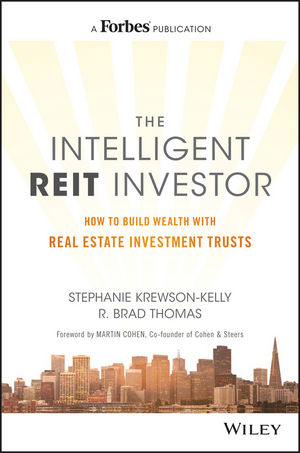
The Intelligent REIT Investor
John Wiley & Sons Inc (Verlag)
978-1-119-25271-9 (ISBN)
- Titel erscheint in neuer Auflage
- Artikel merken
The go-to guide for smart REIT investing The Intelligent REIT Investor is the definitive guide to real estate investment trusts, providing a clear, concise resource for individual investors, financial planners, and analysts anyone who prioritizes dividend income and risk management as major components to wealth-building. Later this year, the REIT industry will experience a watershed event when Standard & Poors creates a new Global Industry Classification Standard (GICS) sector called Real Estate. On September 1st, publicly traded equity REITs will be removed from Financials, where they have been classified since their creation in 1960, and begin trading as their own S&P Sector. This separation from banks and financial institutions already is attracting new investors, but REITs require an industry-specific knowledge that is neither intuitive or readily accessible to newcomers until now. Using straightforward language and simple example to illustrate important concepts, this book will enable any reader to quickly learn and understand the lexicon and valuation techniques used in REIT investing, providing a wealth of practical resources that streamline the learning process.
The discussion explains terminology, metrics, and other key points, while examples illustrate the calculations used to evaluate opportunities. A comprehensive list of publicly-traded REITs provides key reference, giving you access to an important resource most investors and stockbrokers lack. REITs are companies that own or finance commercial rental properties, such as malls and apartment buildings. Despite historically high total returns relative to other investments, such as the Nasdaq or S&P 500 index, most investors are unfamiliar with the REIT industry, and wary of investing without adequate background. This book gets you up to speed on the essentials of REIT investing so you can make more informed and profitable decisions. * Understand REITs processes, mechanisms, and industry * Calculate key metrics to identify suitable companies * Access historical performance tables and industry-specific terminology * Identify publicly-traded REITs quickly and easily REITs have consistently outperformed many more widely known investments. Over the past 15-year period, for example, REITs returned an average of 11% per year, better than all other asset classes.
Since 2009, REITs have enjoyed positive returns; large cap stocks and cash are the only other classes that paralleled that record. Even in 2015, a 'year of fear' related to rising rates, REITs returned 2.4%, beating most all other asset classes. REITs have a long history (over fifty years) of performance, and are about to enter the big leagues. If you feel like you've been missing out, don't keep missing out. Prepare yourself, and your portfolio, to benefit from the demand for REITs that will follow the creation of a Real Estate GICS sector. The Intelligent REIT Investor gives you the information you need to invest wisely and manage your real estate risk effectively. By maintaining a tactical exposure in the brick and mortar asset class, investors should benefit from the information contained in The Intelligent REIT Investor. Join the REIT world and look forward to owning stocks that will help you to sleep well at night.
Stephanie Krewson-Kelly analyzed REITs for top Wall Street firms from 1994 through 2009 and, today, heads the Investor Relations department for a publicly traded REIT. Her prior publications include REIT Roadmap: An Insider's Guide to Successful Investing in Real Estate Investment Trusts (2nd edition, 2012). R. Brad Thomas is an acknowledged expert in commercial real estate investing and REITs. He is editor of the Forbes Real Estate Investor newsletter and writes for Forbes and Seeking Alpha.
Foreword xi Preface xv Acknowledgments xix About the Author xxi Part I An Introduction to REITs 1 Chapter 1 What Is a REIT? 3 Size of the REIT Industry 4 Categories of REITs 4 Equity REITs 4 Mortgage REITs 6 Classification by Property Type 7 Size and Index Inclusion 7 Geographic Focus 9 Growth Strategy 12 Where to Find Information on REITs 15 FTSE NAREIT All REITs Index 15 Company-Specific Websites 15 Indexes for Tracking REIT Performance 15 Exchange-Traded Funds for Investing in REITs 17 Chapter 2 Why Invest in REITs? 19 Double-Digit Total Returns 19 Dividends 20 Liquidity 20 Portfolio Diversification 21 Hedge Against Inflation 23 Transparent Corporate Structures 25 Chapter 3 REIT Dividends 27 Rockland REIT 27 REIT Yields 27 Are REIT Yields Safe? 30 Quantifying Dividend Safety 31 Dividend/FFO Payout Ratio 31 Debt Ultimately Determines Dividend Safety 32 Debt-to Total Market Capitalization Ratio 32 Debt-to Gross Book Value Ratio 32 Legal Standing of Leases Supports Dividend Safety 33 REIT Dividends and Taxation 34 REITs Do Not Pay Out All of Their Cash in Dividends 35 The Components of a REIT s Common Dividend 36 REIT Dividends and the Bush Tax Cuts 39 Preferred Stock Dividends 40 Preferred Stock Basics 40 Risks to Owning Preferred Shares 40 Conclusion 42 Chapter 4 Leases 43 Lease Terminology 44 The Four Major Types of Leases 48 Leases and Tenant Bankruptcy 51 FASB and the New Standard for Accounting for Leases 52 Lease Duration and REIT Stock Price Performance 52 Chapter 5 REITs by Property Type 55 Diversified and Specialized REITs 55 REITs that use Triple-Net-Leases 56 Risks and Rewards of REITs That Use Triple-Net Leases 59 Health-Care REITs 59 Risks and Rewards of Health-care REITs 61 Industrial REITs 62 Risks and Rewards of Industrial REITs 63 Lease Terms 63 Lodging/Resort REITs 63 Hotel Revenue 64 Hotel Expenses 64 Technical Aspects Specific to Hotel REITs 64 Risks and Rewards of Hotel REITs 66 Mortgage REITs 66 Risks and Rewards of Mortgage REITs 69 Office REITs 70 Lease Terms 72 Risks and Rewards of Office REITs 72 Residential REITs 73 Apartment REITs 73 Manufactured Housing REITs 75 Single-Family-Home REITs 76 Retail REITs 77 Shopping Center REITs 77 Mall REITs 79 Freestanding Retail REITs 80 Risks and Rewards of Retail REITs 81 Self-Storage REITs 82 Risks and Rewards of Self-Storage REITs 82 Conclusion 83 Part II Investing in REITs 85 Chapter 6 Getting Technical 87 REIT Structures 87 UPREITs 88 OP Units 89 OP Units and Estate Planning 90 DownREITs 91 Publicly Traded, Public Nonlisted, and Private REITs 92 Volatility versus Liquidity 92 Transparency and Corporate Governance 92 Costs and Fees 95 Externally Advised and Externally Managed REITs 95 Qualifying as a REIT 96 REITs Are Not Limited Partnerships 98 Chapter 7 REIT Performance 99 Historical Total Returns 99 Factors Influencing Demand for REIT Shares 101 Events That Increased Demand for REIT Shares 102 REITs versus the Attractiveness of Other Investments (Lessons from History) 108 Growth Stocks versus REITs, 1998 1999 108 Treasury Yield versus REITs, 2004 2006 109 Safety and Yield, and the Big League of Benchmarks, 2000 2006 110 REITs During the Financial Crisis of 2007 2008 111 Company Attributes That Affect Performance 113 Real Estate Fundamentals and REIT Performance 113 Performance by Property Type 116 How Lease Length and Structure Affect REIT Returns 122 Weighted Average Cost of Capital and REIT Performance 127 Debt as a Four-Letter Word 127 Competitive Advantage or Disadvantage Why Cost of Capital Matters 127 REIT Performance in a Rising Interest Rate Environment 129 Conclusion 131 Chapter 8 Analyzing REITs 133 Operating Metrics 134 Net Operating Income (NOI) 134 Same-Store (Organic) Earnings 134 Earnings Growth for REITs Is FFO Growth 135 Management s Track Record as a Screening Tool 136 Profitability Metrics 137 Funds from Operation 137 Adjusted Funds from Operations (AFFO) 139 Cash Available for Distribution (CAD) 140 Balance Sheet Metrics and Analysis 140 Leverage 140 Debt-to Total Market Capitalization Ratio 141 Debt-to Gross Book Value Ratio 142 Debt-to-EBITDA Ratio 142 Weighted Average Cost of Capital (WACC) 143 Valuation Metrics 145 Price/Earnings Multiple 145 PEG Ratios 145 Dividend Yield 146 Dividend Safety 147 Dividend Coverage, or Payout Ratios 147 Dividend Discount Model 148 Net Asset Valuation (NAV) 149 Implied Capitalization Rate 158 Conclusion 161 Appendix A REITs Listed Alphabetically by Company Name 167 Appendix B REITs Listed Alphabetically by Ticker Symbol 175 Appendix C REITs by Sector 182 Appendix D REITs with Credit Ratings 193 Glossary 199 Index 209
| Erscheinungsdatum | 04.10.2016 |
|---|---|
| Verlagsort | New York |
| Sprache | englisch |
| Maße | 163 x 238 mm |
| Gewicht | 426 g |
| Themenwelt | Wirtschaft ► Betriebswirtschaft / Management ► Rechnungswesen / Bilanzen |
| Betriebswirtschaft / Management ► Spezielle Betriebswirtschaftslehre ► Immobilienwirtschaft | |
| ISBN-10 | 1-119-25271-7 / 1119252717 |
| ISBN-13 | 978-1-119-25271-9 / 9781119252719 |
| Zustand | Neuware |
| Haben Sie eine Frage zum Produkt? |
aus dem Bereich



